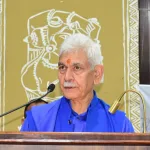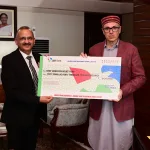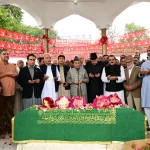The centuries-old popular Darvish dance, locally known as Dhambali, has almost turned one of the outdated performing arts of Kashmir valley. Since few decades back it was considered as one of the most popular dances of Kashmir and was played at the major Sufi Shrines and on different cultural and social events with in the valley villages. But things have changed; this art has lost its popularity and is nowadays rarely performed on certain special occasions of few Sufi saints or at few organized cultural shows.
The community of the artists called ‘Bhands’ or ‘Dhambali Faqir’ have also given up the art and have searched for alternatives as Dhambali no longer earned them any such livelihood.
The new social orders and the indifference of the authorities towards its artists that be, according to the artists, are the causes of decline of the art. Muhammad Ramzan Bhand, who is in nineties while remembering his young age olden days says, ‘Those days have become now a memory when Dhambali Faqirs were treated as dervishes and esteemed artists. The people had a spiritual association with dhamablis and they would consider us as one of the means of connecting with GOD. We would be dancing on the tones of dole while raising our hands and would pray for the peace and prosperity of our nation. Indeed there would be individual prayers as well. The people would share their grief and anxiety with us and would compel us to raise our hands for their respective prayers (Dua).’
In fact things look to have changed so fast that this dance has not only lost its sanctity but its social and cultural concurrence as well. The artists associated with this trade felt social alienation; they say people no longer like the dance and treat it as a somewhat inferior form of art. They claim that even their grown-ups do not like to be called sons of Bhands or dhamali Fakirs.
Ghulam Rasool Bhand, while seconding the views says “The government never took this art seriously and the artists had to face difficult times. The Dhambali dance of Kashmir neither was ever reorganized nor was ever recognized as an institutional art. It was only on local social and cultural levels recognized by the local people and its artists, which with the change in the social and cultural fabric also lost its social concurrence. Since in its last phase it has also lost its spiritual sanctity and with the expansion of various progressive religious thoughts and with advancement of science and technology and other entertainment Sources , this centuries old spiritual dance has almost extinguished from this society.
This dhamabli dance basically was a type of spiritual dance, called Sufi whirling or Semazen borrowed basically from Persian Sama-zan, Sama, meaning listening, and zan, meaning doer. It is form of physically active meditation which originated among certain Sufi groups, which is still practiced by the Sufi Dervishes of the Mevlevi order and other orders such as the Rifa’i-Marufi. It is a customary meditation practice performed within the sema, or worship ceremony, through which dervishes also called semazens, from Persian aim to reach greater connection with Allah (SWT) and His beloved Prophet (SAW). This is sought through abandoning one’s nafs, ego or personal desires, by listening to the music, focusing on God, and spinning one’s body in repetitive circles, which has been seen as a symbolic imitation of planets in the Solar System orbiting around the sun.
Originally this Darvesh dances evolved from Turkey in the 13th century AD, during the times of grand Sufi mystic Moulana Rumi (RA). It is said that his followers and his son Sultan Walad Sultan founded the Mawlawiyah Sufi order, also known as the Order of the Whirling Dervishes, that is famous for its Sufi dance known as the sama ceremony. The people who perform this Sama are called Dervishes and are held in high regard by the Sufis of Turkey.
It is at this Sufi centre that the followers of Rumi’s school of thought gather at his tomb and present Sama. The followers first make circles and then dance while standing in chorus.
It is said that from here this Sufi practice travelled to central Asian states and also reached Kashmir, while reaching Kashmir it changed its name from Darvish dance to Dhambali dance.
In kashmiri form they have also added double sided dol (drumbeating). The dervishes would come into groups with dol beaters, in their distinctive dresses and with their distinctive flags symbolizing their respective identities. They would also perform into different groups. They would first make circles and then they within these circles would turn by turn make jumping steps on the tunes of dol. The dancer would go deep in the tunes of the dole, which is a kind of meditation. The dancer would not stop until he falls unconscious. Then he is taken away from the chorus and the next will start his performance. The show goes on until all performers, perform their respective dance activity. In conclusion all performers of the group will join the chorus and raise hands for prayers. The entire concert reflects a spiritual meditation where not only its performers, but the people watching the concert also dip deep into this whirling.
Many kashmiri Sufis followed and promoted it in their respective Khanqahs. This spiritual whirling spread to the distant lands of this glorious valley and gradually it became the traditional art of Kashmir. The performers of this art came to be known as Fakirs and bands which later grew as a separate community.
Baba Naseeb Ud Din Gazi (RA) the most learned Sufi of this land also followed the Mawlawiyah Sufi order and adopted it for its spiritual pursuits. This sprituall dance also helped him to connect people with his Khanqah where he also has been distributing alms among the orphans and poor people. He would also involve people in social and public works.
Baba Naseem ud din Gazi’s Khanqah is situated at Baba mohallal in the historic town of Bijbehara, in south kashmir. He is also titled as ‘Abul Fuqra’, the father of the poor. It is said that the saint had spent his entire life caring for orphans, poor and the destitute and building of Khanqahs and Mosques. A curious legend associated with this saint states that about 1200 Khanqahs and mosques has been built by him.
The spiritual dance was also used to call people for participating in public works and constructions. The tradition continued for very long and later on this spiritual dance got permanently associated with his shrine and other Sufi shines of this land.
Every year during the Urs celebrations of the Baba, a massive congregation of the Dhambali dance is held to commemorate the spiritual and social achievements of this saint. The dhamalies of Ikengam, Mohdipora, Wathura, Imam Sahib, Kalishah Sahib, Parigam, Chambagund, and other scores of places throng to his khanqah and demonstrate their dancing skills. These dhamali artists make chorus and dance on the tunes of drum beaters and in this way they think have been paying rich tributes to their saint.( the tradition has almost declined and nowadays little functions are held to symbolically celebrate the event)
Besides losing its popularity, this Darvish or Damali dance also could not preserve its spiritual sanctity. Its performers turned to be entertainers rather than Sufi performers. Since, they did not respect their art which resulted in their disrespect as well. They could also not get better treatment and over all the community became a neglected lot. In fact most of the people could not understand the real meaning of fakir and spiritual essence of this dance. Its performers also could not carry forward its spiritual aspect. They also tempered with its basic tents and spiritual essence. Gradually later on it turned as one of folk dance of this land.
Presently the dhamali institution is in shambles while artists performing this art have also shifting towards other trades. As such the centuries old Dhamali dance has almost vanished from the cultural scene of this land.
(The writer is senior archaeologist and columnist. Email: [email protected])





